2020 Hyundai Ioniq Hybrid warning
[x] Cancel search: warningPage 1 of 613
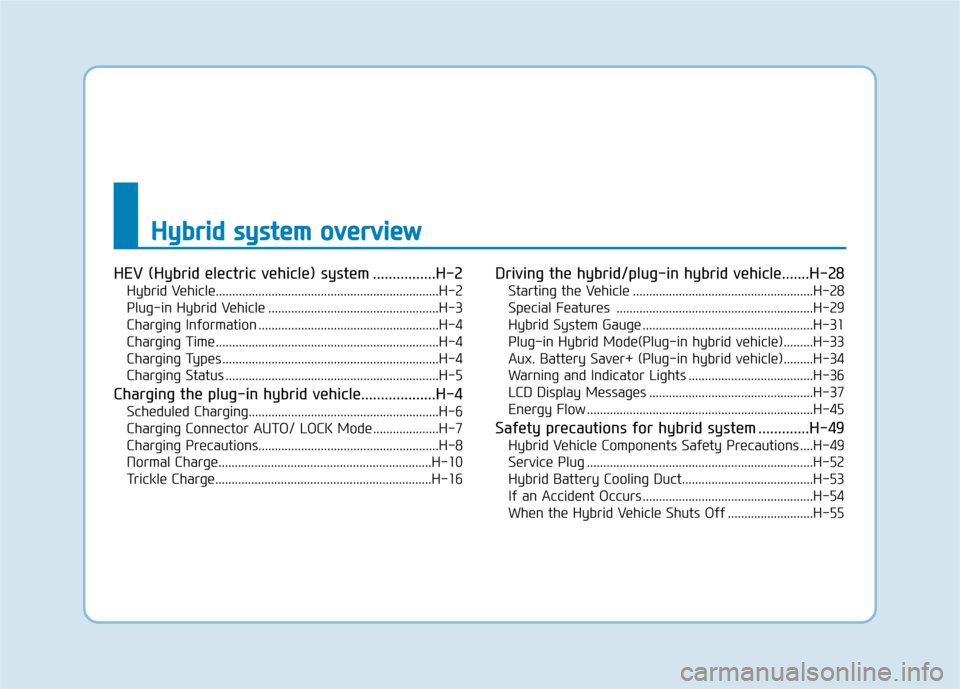
HEV (Hybrid electric vehicle) system ................H-2
Hybrid Vehicle....................................................................H-2
Plug-in Hybrid Vehicle ....................................................H-3
Charging Information .......................................................H-4
Charging Time....................................................................H-4
Charging Types ..................................................................H-4
Charging Status .................................................................H-5
Charging the plug-in hybrid vehicle...................H-4
Scheduled Charging..........................................................H-6
Charging Connector AUTO/ LOCK Mode ....................H-7
Charging Precautions.......................................................H-8
Normal Charge.................................................................H-10
Trickle Charge..................................................................H-16
Driving the hybrid/plug-in hybrid vehicle.......H-28
Starting the Vehicle .......................................................H-28
Special Features ............................................................H-29
Hybrid System Gauge ....................................................H-31
Plug-in Hybrid Mode(Plug-in hybrid vehicle).........H-33
Aux. Battery Saver+ (Plug-in hybrid vehicle).........H-34
Warning and Indicator Lights ......................................H-36
LCD Display Messages ..................................................H-37
Energy Flow .....................................................................H-45
Safety precautions for hybrid system .............H-49
Hybrid Vehicle Components Safety Precautions ....H-49
Service Plug .....................................................................H-52
Hybrid Battery Cooling Duct........................................H-53
If an Accident Occurs ....................................................H-54
When the Hybrid Vehicle Shuts Off ..........................H-55
H Hy
yb
br
ri
id
d
s
sy
ys
st
te
em
m
o
ov
ve
er
rv
vi
ie
ew
w
Page 8 of 613
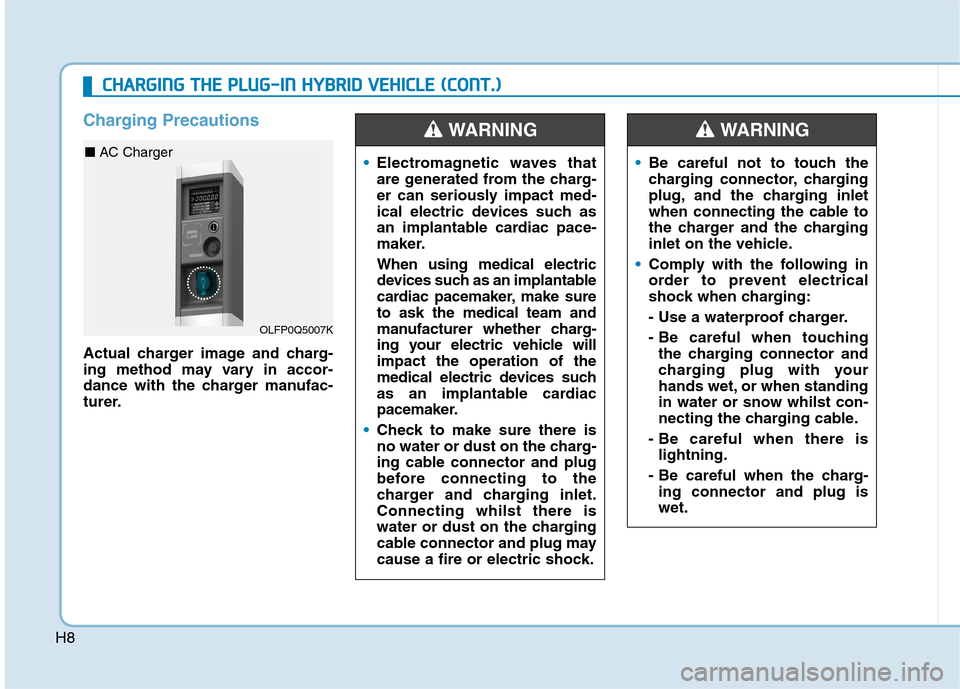
H8
Charging Precautions
Actual charger image and charg-
ing method may vary in accor-
dance with the charger manufac-
turer.
Electromagnetic waves that
are generated from the charg-
er can seriously impact med-
ical electric devices such as
an implantable cardiac pace-
maker.
When using medical electric
devices such as an implantable
cardiac pacemaker, make sure
to ask the medical team and
manufacturer whether charg-
ing your electric vehicle will
impact the operation of the
medical electric devices such
as an implantable cardiac
pacemaker.
Check to make sure there is
no water or dust on the charg-
ing cable connector and plug
before connecting to the
charger and charging inlet.
Connecting whilst there is
water or dust on the charging
cable connector and plug may
cause a fire or electric shock.
WARNING
Be careful not to touch the
charging connector, charging
plug, and the charging inlet
when connecting the cable to
the charger and the charging
inlet on the vehicle.
Comply with the following in
order to prevent electrical
shock when charging:
- Use a waterproof charger.
- Be careful when touching
the charging connector and
charging plug with your
hands wet, or when standing
in water or snow whilst con-
necting the charging cable.
- Be careful when there is
lightning.
- Be careful when the charg-
ing connector and plug is
wet.
WARNING
OLFP0Q5007K
■ AC Charger
C
CH
HA
AR
RG
GI
IN
NG
G
T
TH
HE
E
P
PL
LU
UG
G-
-I
IN
N
H
HY
YB
BR
RI
ID
D
V
VE
EH
HI
IC
CL
LE
E
(
(C
CO
ON
NT
T.
.)
)
Page 9 of 613
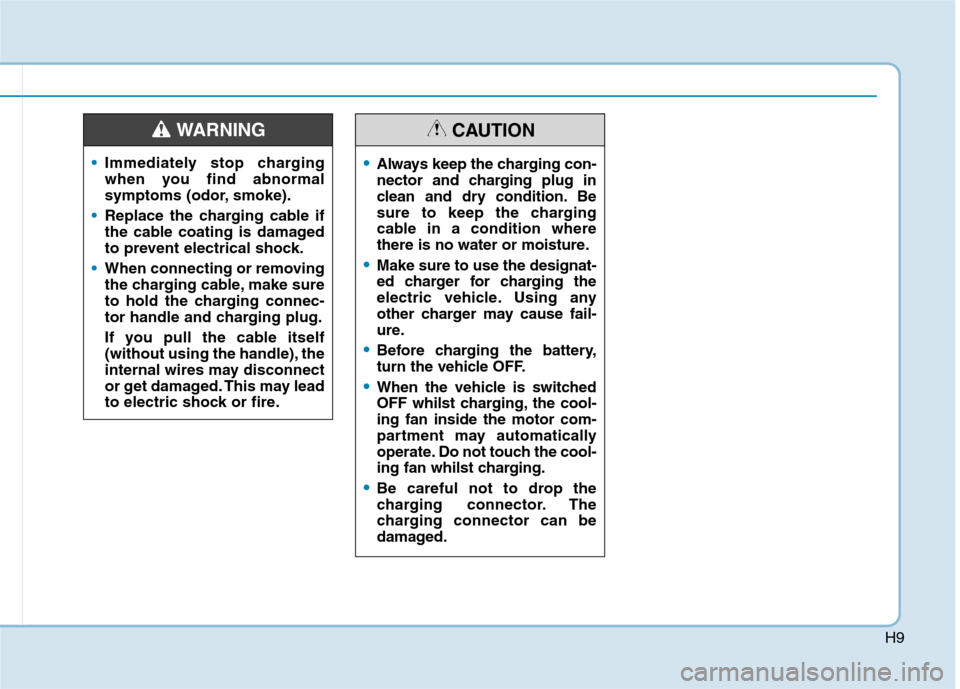
H9
Immediately stop charging
when you find abnormal
symptoms (odor, smoke).
Replace the charging cable if
the cable coating is damaged
to prevent electrical shock.
When connecting or removing
the charging cable, make sure
to hold the charging connec-
tor handle and charging plug.
If you pull the cable itself
(without using the handle), the
internal wires may disconnect
or get damaged. This may lead
to electric shock or fire.
WARNING
Always keep the charging con-
nector and charging plug in
clean and dry condition. Be
sure to keep the charging
cable in a condition where
there is no water or moisture.
Make sure to use the designat-
ed charger for charging the
electric vehicle. Using any
other charger may cause fail-
ure.
Before charging the battery,
turn the vehicle OFF.
When the vehicle is switched
OFF whilst charging, the cool-
ing fan inside the motor com-
partment may automatically
operate. Do not touch the cool-
ing fan whilst charging.
Be careful not to drop the
charging connector. The
charging connector can be
damaged.
CAUTION
Page 23 of 613
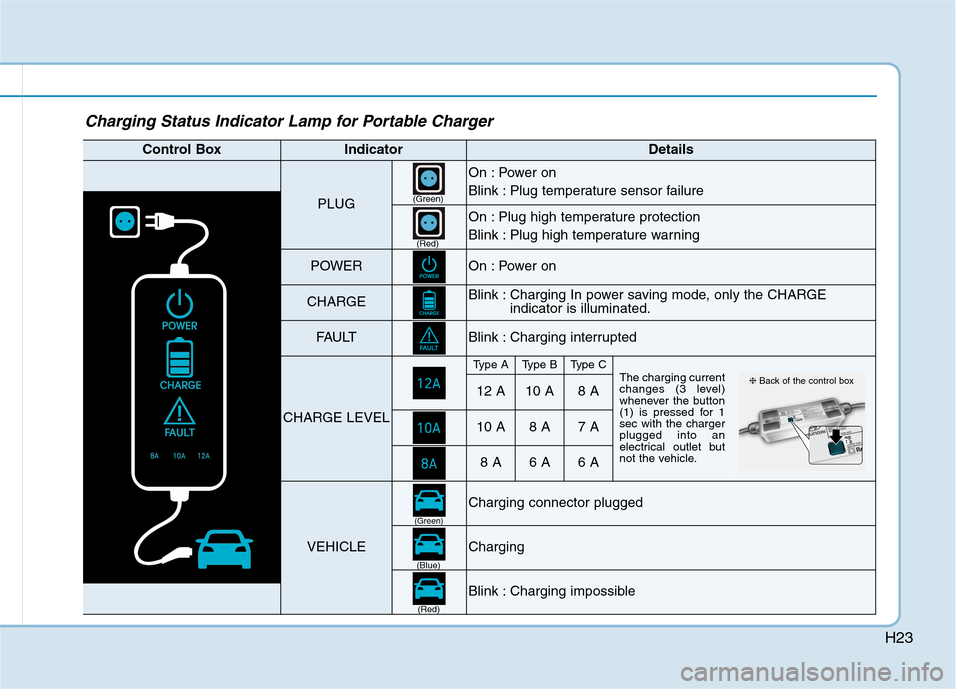
H23
Charging Status Indicator Lamp for Portable Charger
Control BoxIndicatorDetails
PLUG
On : Power on
Blink : Plug temperature sensor failure
On : Plug high temperature protection
Blink : Plug high temperature warning
POWEROn : Power on
CHARGEBlink : Charging In power saving mode, only the CHARGE
indicator is illuminated.
FAU LTBlink : Charging interrupted
CHARGE LEVEL
Type AType BType CThe charging current
changes (3 level)
whenever the button
(1) is pressed for 1
sec with the charger
plugged into an
electrical outlet but
not the vehicle.12 A10 A8 A
10 A8 A7 A
8 A6 A6 A
VEHICLE
Charging connector plugged
Charging
Blink : Charging impossible
(Green)
(Green)
(Blue)
(Red) (Red)
❈Back of the control box
Page 24 of 613
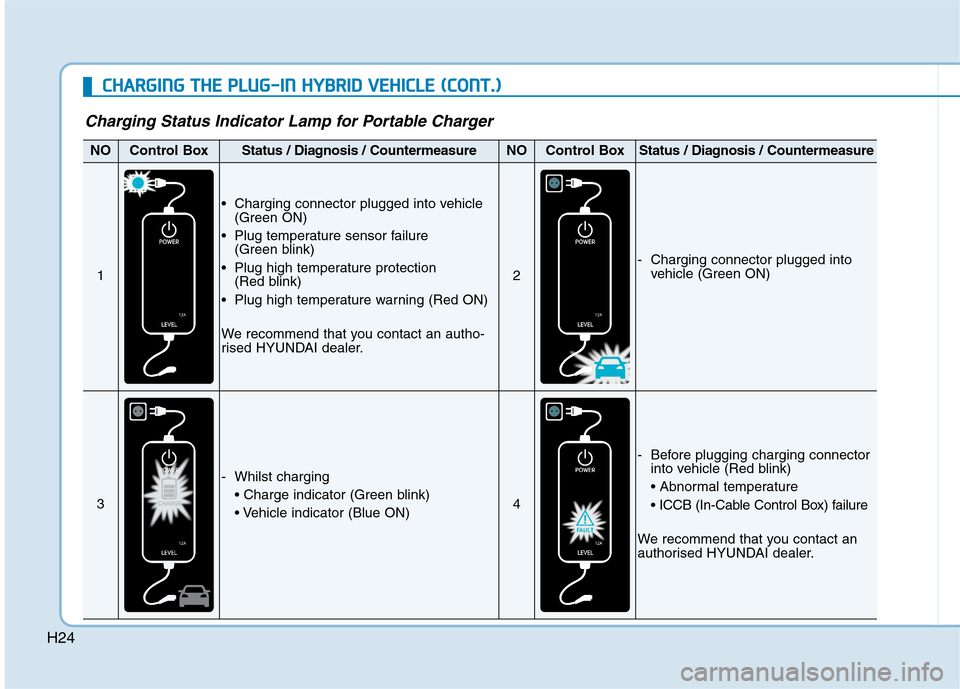
H24
Charging Status Indicator Lamp for Portable Charger
NOControl BoxStatus / Diagnosis / CountermeasureNOControl BoxStatus / Diagnosis / Countermeasure
1
Charging connector plugged into vehicle
(Green ON)
Plug temperature sensor failure
(Green blink)
Plug high temperature protection
(Red blink)
Plug high temperature warning (Red ON)
We recommend that you contact an autho-
rised HYUNDAI dealer.
2
- Charging connector plugged into
vehicle (Green ON)
3
- Whilst charging
4
- Before plugging charging connector
into vehicle (Red blink)
We recommend that you contact an
authorised HYUNDAI dealer.
C CH
HA
AR
RG
GI
IN
NG
G
T
TH
HE
E
P
PL
LU
UG
G-
-I
IN
N
H
HY
YB
BR
RI
ID
D
V
VE
EH
HI
IC
CL
LE
E
(
(C
CO
ON
NT
T.
.)
)
Page 25 of 613
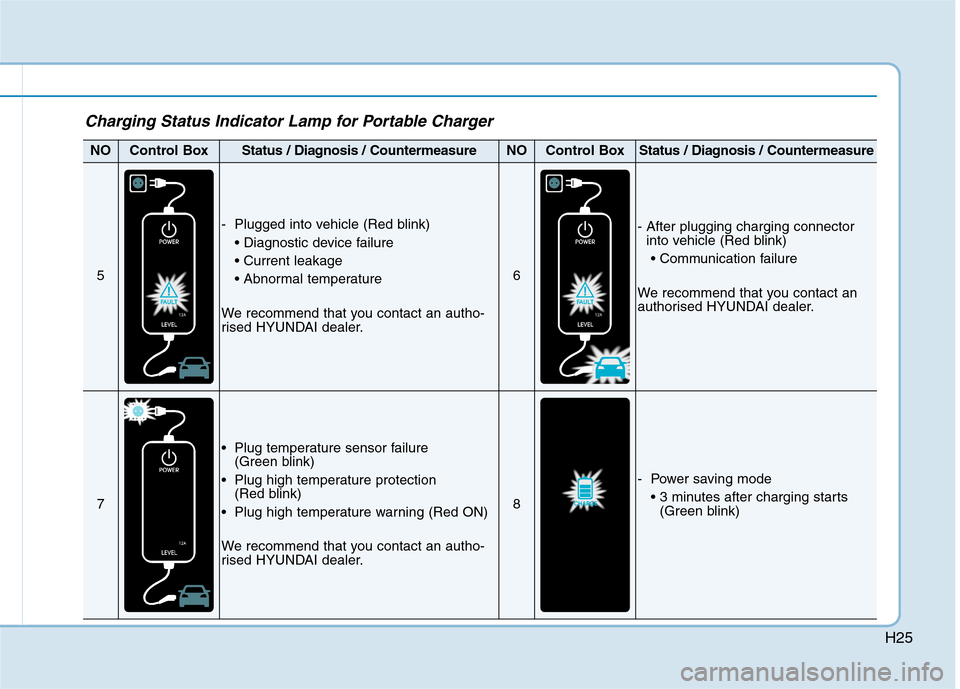
H25
NOControl BoxStatus / Diagnosis / CountermeasureNOControl BoxStatus / Diagnosis / Countermeasure
5
- Plugged into vehicle (Red blink)
We recommend that you contact an autho-
rised HYUNDAI dealer.
6
- After plugging charging connector
into vehicle (Red blink)
We recommend that you contact an
authorised HYUNDAI dealer.
7
Plug temperature sensor failure
(Green blink)
Plug high temperature protection
(Red blink)
Plug high temperature warning (Red ON)
We recommend that you contact an autho-
rised HYUNDAI dealer.
8
- Power saving mode
(Green blink)
Charging Status Indicator Lamp for Portable Charger
Page 28 of 613
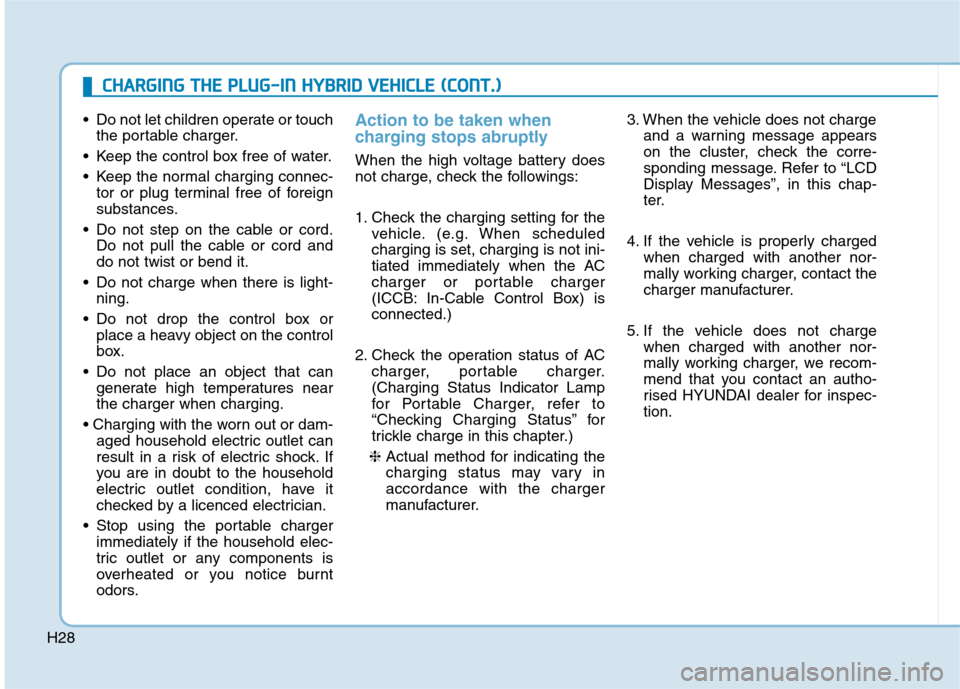
H28 Do not let children operate or touch
the portable charger.
Keep the control box free of water.
Keep the normal charging connec-
tor or plug terminal free of foreign
substances.
Do not step on the cable or cord.
Do not pull the cable or cord and
do not twist or bend it.
Do not charge when there is light-
ning.
Do not drop the control box or
place a heavy object on the control
box.
Do not place an object that can
generate high temperatures near
the charger when charging.
aged household electric outlet can
result in a risk of electric shock. If
you are in doubt to the household
electric outlet condition, have it
checked by a licenced electrician.
Stop using the portable charger
immediately if the household elec-
tric outlet or any components is
overheated or you notice burnt
odors.
Action to be taken when
charging stops abruptly
When the high voltage battery does
not charge, check the followings:
1. Check the charging setting for the
vehicle. (e.g. When scheduled
charging is set, charging is not ini-
tiated immediately when the AC
charger or portable charger
(ICCB: In-Cable Control Box) is
connected.)
2. Check the operation status of AC
charger, portable charger.
(Charging Status Indicator Lamp
for Portable Charger, refer to
“Checking Charging Status” for
trickle charge in this chapter.)
❈Actual method for indicating the
charging status may vary in
accordance with the charger
manufacturer.3. When the vehicle does not charge
and a warning message appears
on the cluster, check the corre-
sponding message. Refer to “LCD
Display Messages”, in this chap-
ter.
4. If the vehicle is properly charged
when charged with another nor-
mally working charger, contact the
charger manufacturer.
5. If the vehicle does not charge
when charged with another nor-
mally working charger, we recom-
mend that you contact an autho-
rised HYUNDAI dealer for inspec-
tion.
C CH
HA
AR
RG
GI
IN
NG
G
T
TH
HE
E
P
PL
LU
UG
G-
-I
IN
N
H
HY
YB
BR
RI
ID
D
V
VE
EH
HI
IC
CL
LE
E
(
(C
CO
ON
NT
T.
.)
)
Page 31 of 613
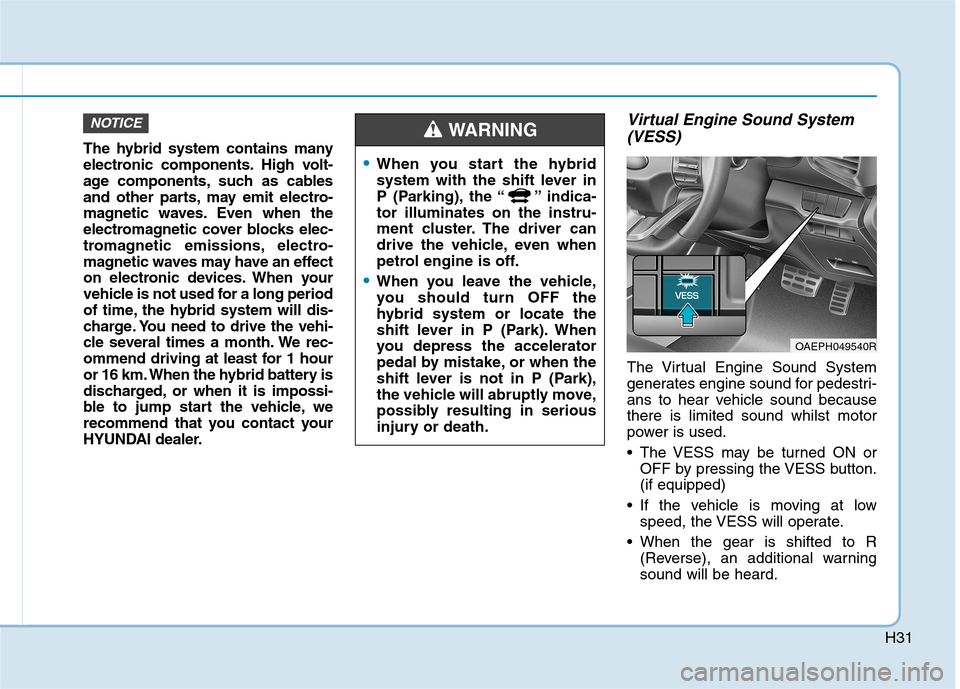
H31
The hybrid system contains many
electronic components. High volt-
age components, such as cables
and other parts, may emit electro-
magnetic waves. Even when the
electromagnetic cover blocks elec-
tromagnetic emissions, electro-
magnetic waves may have an effect
on electronic devices. When your
vehicle is not used for a long period
of time, the hybrid system will dis-
charge. You need to drive the vehi-
cle several times a month. We rec-
ommend driving at least for 1 hour
or 16 km. When the hybrid battery is
discharged, or when it is impossi-
ble to jump start the vehicle, we
recommend that you contact your
HYUNDAI dealer.
Virtual Engine Sound System
(VESS)
The Virtual Engine Sound System
generates engine sound for pedestri-
ans to hear vehicle sound because
there is limited sound whilst motor
power is used.
The VESS may be turned ON or
OFF by pressing the VESS button.
(if equipped)
If the vehicle is moving at low
speed, the VESS will operate.
When the gear is shifted to R
(Reverse), an additional warning
sound will be heard.
NOTICE
When you start the hybrid
system with the shift lever in
P (Parking), the “ ” indica-
tor illuminates on the instru-
ment cluster. The driver can
drive the vehicle, even when
petrol engine is off.
When you leave the vehicle,
you should turn OFF the
hybrid system or locate the
shift lever in P (Park). When
you depress the accelerator
pedal by mistake, or when the
shift lever is not in P (Park),
the vehicle will abruptly move,
possibly resulting in serious
injury or death.
WARNING
OAEPH049540R